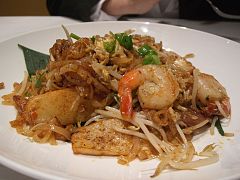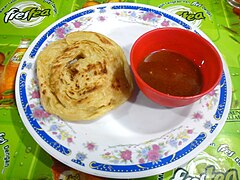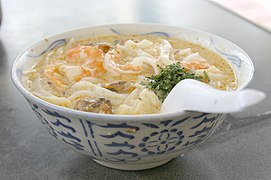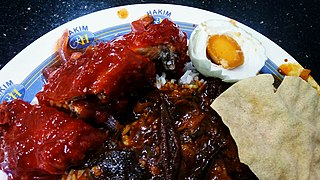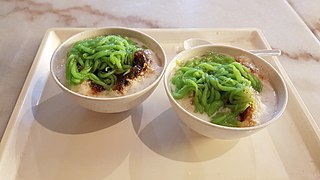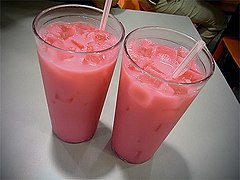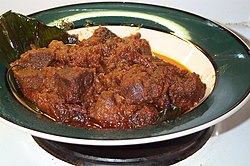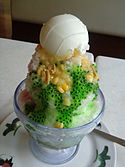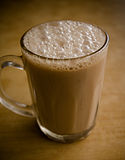Malajská kuchyně



Malajská kuchyně (malajsky: Masakan Malaysia) je velice rozmanitá a mísí se v ní vlivy z mnoha kuchyní (především z čínské a indické, ale i z kuchyně místních domorodcům, thajské, portugalské, nizozemské, arabské nebo britské kuchyně). Malajská kuchyně je podobná ostatním kuchyním v regionu, především indonéské. Mezi nejpoužívanější suroviny patří rýže, nudle, zelenina kokos (kokosové mléko) a maso. Na ochucování jídel se velmi často používá pikantní kořenící pasta sambal, ale i chilli, citronová tráva nebo kari. Populární je také čerstvé ovoce, Malajsie je známá svými duriany a chlebovníky. Za centrum malajské kuchyně je považováno města Penang.[1][2][3][4]
Příklady malajských pokrmů
Příklady malajských pokrmů:[1][2][3][4]
- Nasi lemak, pokrm často považovaný za malajské národní jídlo. Jedná se o rýži vařenou v kokosovém mléce, podávanou se sušenými ančovičkami, sambalem, arašídy a vejcem.
- Char koay teow, smažený nudlový pokrm s krevetami, vejcem a mungo klíčky, podobný thajskému phad thai
- Nasi goreng, smažená rýže
- Roti canai, indický chléb roti podávaný s kari
- Rendang, pikantní hovězí pomalu vařené v kokosovém mléce
- Rojak, ovocný salát s pikantním dresinkem
- Laksa, polévka jejíž základem je kokosové mléko a vývar (obvykle rybí), s nudlemi nebo rýží
- Nasi kandar, rýže s kari omáčkou
- Cendol, zelené želé z rýže nebo mungo fazolí
- Ais kacang, mražený dezert z ledu a fazolí, podávaný s želé, kondenzovaným mlékem nebo cendolem
- Hokkien mee, vývar z vepřových kostí a krevet, podávaný s nudlemi, sambalem, zeleninou a krevetami
- Keropok lekor, slané kousky rybího masa, s pikantní omáčkou, specialita Terengganu
- Kuih, různé sladkosti s konzistencí pudinku
- Nasi dagang, rýže vařená v kokosovém mléce, podávaná s rybím masem a nakládanou zeleninou
Galerie
- Nasi lemak
- Char koay teow
- Nasi goreng
- Roti canai
- Rendang
- Rojak
- Laksa
- Nasi kandar
- Cendol
- Ais kacang
- Hokkien mee
- Keropok lekor
- Kuih
- Nasi dagang
Příklady malajských nápojů
Příklady malajských nápojů:[1][5]
- Čaj, malajskou specialitou je teh tarik (v překladu táhlý čaj). Jedná se o sladký nápoj z černého čaje, cukru a kondenzovaného mléka.
- Káva, specialitou je bílá káva z Ipohu, jejíž kávová zrna jsou pražena speciální technikou
- Bandung, sladký nápoj jasně růžové barvy, ochucený růžovým sirupem
- Kokosové mléko
- Ačkoliv je Malajsie muslimská země jsou k dostání alkoholické nápoje, jako pivo, víno nebo rýžový alkoholický nápoj lihing (specialita Sabahu)
Galerie
- Teh tarik
- Bandung
- Kokosové mléko
- Photo by CEphoto, Uwe Aranas or alternatively © CEphoto, Uwe Aranas, CC BY-SA 3.0Alkoholické nápoje Sabahu
Reference
V tomto článku byl použit překlad textu z článku Malaysian cuisine na anglické Wikipedii.
- ↑ a b c World Travel Guide [online]. [cit. 2021-02-11]. Dostupné online. (anglicky)
- ↑ a b Za jídlem do Malajsie. Prima Fresh [online]. [cit. 2021-02-11]. Dostupné online.
- ↑ a b Jídlo v Malajsii a typické speciality | Cestujlevne.com. www.cestujlevne.com [online]. [cit. 2021-02-11]. Dostupné online.
- ↑ a b Malajsie-info.cz / Malajská kuchyně. www.malajsie-info.cz [online]. [cit. 2021-02-11]. Dostupné v archivu pořízeném z originálu dne 2021-01-23.
- ↑ 5 Most Popular Malaysian Beverages. www.tasteatlas.com [online]. [cit. 2021-02-11]. Dostupné online.
Externí odkazy
 Obrázky, zvuky či videa k tématu malajsijská kuchyně na Wikimedia Commons
Obrázky, zvuky či videa k tématu malajsijská kuchyně na Wikimedia Commons
Média použitá na této stránce
Autor: Mw12310, Licence: CC BY-SA 3.0
Nasi Lemak sold with Lamb Curry at Mamak in Sydney, Australia
Photo by CEphoto, Uwe Aranas or alternatively © CEphoto, Uwe Aranas, CC BY-SA 3.0
Kg. Kuai Kandazon, Penampang, Sabah: LIHING, TALAK and SIKAT - Traditional rice liqueurs/schnaps; displayed in the Monsopiad Cultural Village
Two Pieces of Seri Muka cake.
Autor: Kyle Lam, Licence: CC BY-SA 2.0
Bandung, sirap bandung, or air bandung is Singaporean rose cordial syrup flavoured milk, also popular in Brunei, Indonesia and Malaysia.
Artocarpus heterophyllus, bought at the Binnenrotte market in Rotterdam, The Netherlands
Autor: Sofiah Budiastuti, Licence: CC BY-SA 4.0
Rujak Buah is an Indonesian Fruit Salad. It is made of a mixture of fruits and spicy peanut sauce. Pestle and mortar sets are commonly used to make the sauce and to toss the mixture.
A display rack of Durians for sale by a street vendor in Kuala Lumpur, Malaysia
Autor: The Bangsawan, Licence: CC BY-SA 4.0
Nasi Kandar, a Indian-Muslim dish popular in Southeast Asia, specifically in places such as Indonesia, Malaysia and Singapore.
Autor: Jonathan Lin, Licence: CC BY-SA 2.0
in Penang, a midday break consist of Teh Tarik. I wonder why i never saw any chinese do a teh tarik, its just Teh to them.....
and for you who have no idea what i just said, "Teh Tarik" in malay means Pulled Tea, its hard to explain why, you got to see how its prepared. go google it.Autor: Meutia Chaerani / Indradi Soemardjan http://www.indrani.net, Licence: CC BY 2.5
A bowl of Katong Laksa, Singapore
Autor: Orderinchaos, Licence: CC BY-SA 4.0
Chendol at the Cendol Melaka shop at Changi Village food centre, Changi, Singapore.
Autor: Dreamtrooper, Licence: CC BY-SA 3.0
A bowl of Penang Hokkien Prawn Noodles or Hokkien Mee
Mapa Asie
Autor: Gunawan Kartapranata, Licence: CC BY-SA 3.0
Nasi Goreng (Indonesian style fried rice) with pete or petai (green stinky beans) and goat meat. Also accompanied with fried egg, pickles with fresh slices tomato and cucumber, cabbages, fried shallots, chilli, and emping crackers. Hot Rocket restaurant, Sarinah Thamrin, Central Jakarta, Indonesia.
Autor: Alpha from Melbourne, Australia, Licence: CC BY-SA 2.0
We were quite excited to be able to try this new "Malaysian Cuisine" that appeared in Chinatown, especially after several false starts of it being [/photos/avlxyz/3118154414/in/set-72157611093877385/ closed for one-day renovations] a few days after its opening, and queues during lunchtime.
Maybe our expectations of it were too high, but our first impressions was that the coconut rice wasn't that "lemak". In other words, not rich enough in coconut milk and/or pandan leaves, or in their posh terminology, "pandanus". Aiya, call a pandan a pandan lah. The beef rendang was quite good, but wasn't that great. I think I prefer the rendang at Nelayan where the sauce is rich and unctuous. The sambal squid turned out quite well though, tender morsels of fat squid in a good tangy sambal. Julia failed the dish after tasting soggy peanuts and ikan bilis, the deep fried anchovies that are supposed to be crunchy.
Next came the "white coffee" that Old Town Kopitiam supposedly invented, so named after the White Cafe that was its birthplace, or so the story goes on the Old Town White Coffee website. One sip from both of us and our knowing glances at each other signalled, instant coffee. C'mon lah, brew the real stuff.
Our last dish was the Char Kuay Teow. They had ran out of blood cockles, or clams proclaimed the menu, even though it was a AUD2 addition to the dish. Authentic CKT comes with cockles. If you don't like it, exclude it, but perhaps in a nod to Western sensibilities, it is left out. Educate their palates I say. While the noodles and dish itself is not bad, with a faint whiff of smokiness from a hot wok, the noodles were thin, like Pad Thai noodles. Not entirely authentic, but not too bad either. And the prawns were decent sized.
The logo on the signage and menu suggests that it could be somehow related to Old Town White Coffee or Old Town Kopitiam in Malaysia. I should have asked a friendly waiter dressed in black, who i suspect might be the boss or shareholder. Then again, the service was very friendly overall.
Would we go back? Well, I'll at least give it a second chance for the [/photos/avlxyz/4313050123/ curry laksa], assam laksa, chicken curry, or the nasi goreng fried rice. I didn't even manage an Ice Kacang or Cendol. Both sold out, apparently.
Old Town Kopitiam Little Bourke St, Melbourne (previously Banana Palm, between Russell and Swanston Streets)
Photos: - [/photos/avlxyz/3118157168/in/set-72157611093877385/ White Kopi] - [/photos/avlxyz/3117329663/in/set-72157611093877385/ Char Kuay Teow] - AUD9. AUD2 extra for blood cockles. - [/photos/avlxyz/3102439596/in/set-72157611093877385/ Char Kuay Teow] - Jeff's iPhone - [/photos/avlxyz/3118156830/in/set-72157611093877385/ Old Town Kopitiam Nasi Lemak with Beef Rendang and Sambal Squid] - AUD10 - [/photos/avlxyz/3118156344/in/set-72157611093877385/ Top view - Old Town Kopitiam Nasi Lemak with Beef Rendang and Sambal Squid] - AUD10 - [/photos/avlxyz/3117327803/in/set-72157611093877385/ Authentic sauces + trendy display] - [/photos/avlxyz/3117327465/in/set-72157611093877385/ Entrees and rice menu] - [/photos/avlxyz/3117326979/in/set-72157611093877385/ Dessert Menu] - [/photos/avlxyz/3117329961/in/set-72157611093877385/ Decor] - [/photos/avlxyz/3117328095/in/set-72157611093877385/ Dinnertime crowd] - [/photos/avlxyz/3101605603/in/set-72157611093877385/ Under construction]
- [/photos/avlxyz/3118154414/in/set-72157611093877385/ Closed for one-day renovation]Autor: didiz rushdi, Licence: CC BY-SA 2.0
Keropok lekor in Terengganu, Malaysia.

